Md. Abdur Rahman
Hallucination to Truth: A Review of Fact-Checking and Factuality Evaluation in Large Language Models
Aug 05, 2025Abstract:Large Language Models (LLMs) are trained on vast and diverse internet corpora that often include inaccurate or misleading content. Consequently, LLMs can generate misinformation, making robust fact-checking essential. This review systematically analyzes how LLM-generated content is evaluated for factual accuracy by exploring key challenges such as hallucinations, dataset limitations, and the reliability of evaluation metrics. The review emphasizes the need for strong fact-checking frameworks that integrate advanced prompting strategies, domain-specific fine-tuning, and retrieval-augmented generation (RAG) methods. It proposes five research questions that guide the analysis of the recent literature from 2020 to 2025, focusing on evaluation methods and mitigation techniques. The review also discusses the role of instruction tuning, multi-agent reasoning, and external knowledge access via RAG frameworks. Key findings highlight the limitations of current metrics, the value of grounding outputs with validated external evidence, and the importance of domain-specific customization to improve factual consistency. Overall, the review underlines the importance of building LLMs that are not only accurate and explainable but also tailored for domain-specific fact-checking. These insights contribute to the advancement of research toward more trustworthy and context-aware language models.
GHTM: A Graph based Hybrid Topic Modeling Approach in Low-Resource Bengali Language
Aug 01, 2025Abstract:Topic modeling is a Natural Language Processing (NLP) technique that is used to identify latent themes and extract topics from text corpora by grouping similar documents based on their most significant keywords. Although widely researched in English, topic modeling remains understudied in Bengali due to its morphological complexity, lack of adequate resources and initiatives. In this contribution, a novel Graph Convolutional Network (GCN) based model called GHTM (Graph-Based Hybrid Topic Model) is proposed. This model represents input vectors of documents as nodes in the graph, which GCN uses to produce semantically rich embeddings. The embeddings are then decomposed using Non-negative Matrix Factorization (NMF) to get the topical representations of the underlying themes of the text corpus. This study compares the proposed model against a wide range of Bengali topic modeling techniques, from traditional methods such as LDA, LSA, and NMF to contemporary frameworks such as BERTopic and Top2Vec on three Bengali datasets. The experimental results demonstrate the effectiveness of the proposed model by outperforming other models in topic coherence and diversity. In addition, we introduce a novel Bengali dataset called "NCTBText" sourced from Bengali textbook materials to enrich and diversify the predominantly newspaper-centric Bengali corpora.
A Novel Word Pair-based Gaussian Sentence Similarity Algorithm For Bengali Extractive Text Summarization
Nov 26, 2024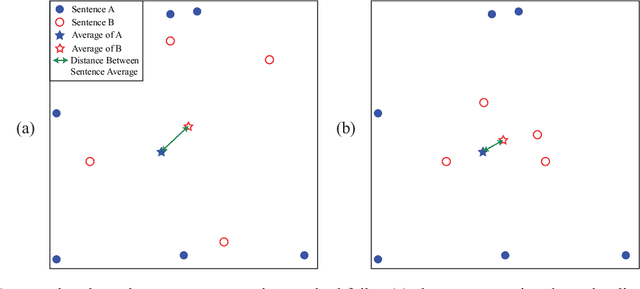

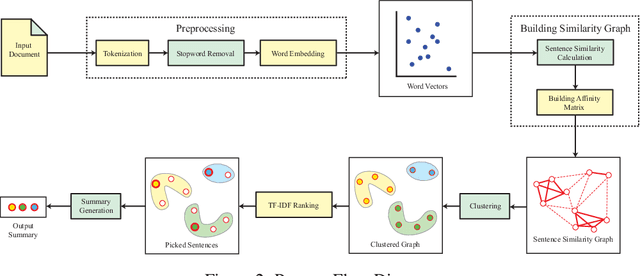

Abstract:Extractive Text Summarization is the process of selecting the most representative parts of a larger text without losing any key information. Recent attempts at extractive text summarization in Bengali, either relied on statistical techniques like TF-IDF or used naive sentence similarity measures like the word averaging technique. All of these strategies suffer from expressing semantic relationships correctly. Here, we propose a novel Word pair-based Gaussian Sentence Similarity (WGSS) algorithm for calculating the semantic relation between two sentences. WGSS takes the geometric means of individual Gaussian similarity values of word embedding vectors to get the semantic relationship between sentences. It compares two sentences on a word-to-word basis which rectifies the sentence representation problem faced by the word averaging method. The summarization process extracts key sentences by grouping semantically similar sentences into clusters using the Spectral Clustering algorithm. After clustering, we use TF-IDF ranking to pick the best sentence from each cluster. The proposed method is validated using four different datasets, and it outperformed other recent models by 43.2\% on average ROUGE scores (ranging from 2.5\% to 95.4\%). It is also experimented on other low-resource languages i.e. Turkish, Marathi, and Hindi language, where we find that the proposed method performs as similar as Bengali for these languages. In addition, a new high-quality Bengali dataset is curated which contains 250 articles and a pair of summaries for each of them. We believe this research is a crucial addition to Bengali Natural Language Processing (NLP) research and it can easily be extended into other low-resource languages. We made the implementation of the proposed model and data public on \href{https://github.com/FMOpee/WGSS}{https://github.com/FMOpee/WGSS}.
Performance Analysis of Deep Autoencoder and NCA Dimensionality Reduction Techniques with KNN, ENN and SVM Classifiers
Dec 24, 2019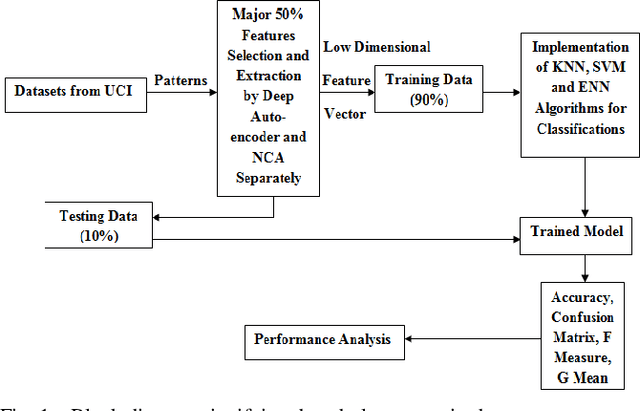
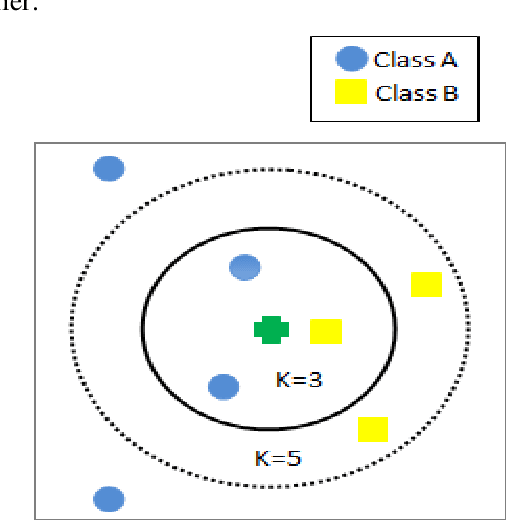
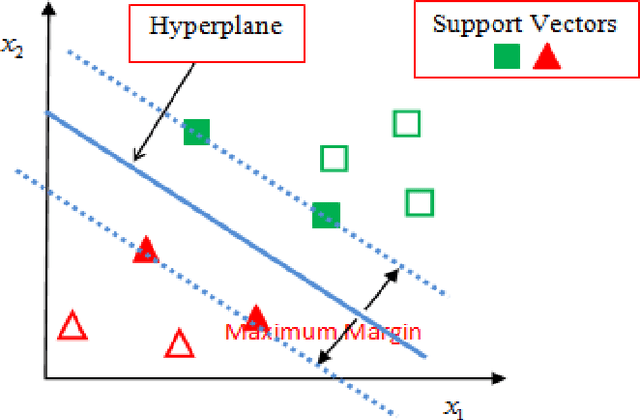
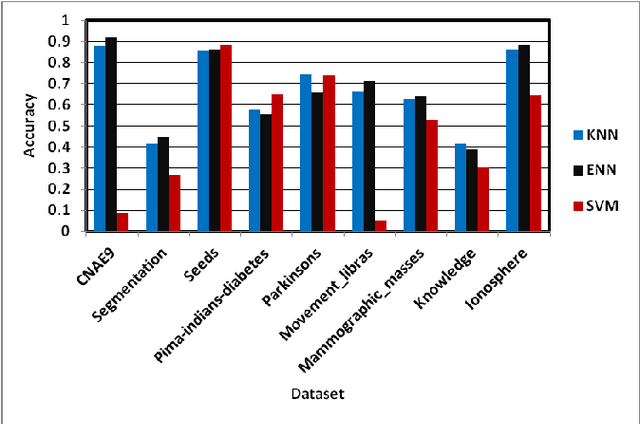
Abstract:The central aim of this paper is to implement Deep Autoencoder and Neighborhood Components Analysis (NCA) dimensionality reduction methods in Matlab and to observe the application of these algorithms on nine unlike datasets from UCI machine learning repository. These datasets are CNAE9, Movement Libras, Pima Indians diabetes, Parkinsons, Knowledge, Segmentation, Seeds, Mammographic Masses, and Ionosphere. First of all, the dimension of these datasets has been reduced to fifty percent of their original dimension by selecting and extracting the most relevant and appropriate features or attributes using Deep Autoencoder and NCA dimensionality reduction techniques. Afterward, each dataset is classified applying K-Nearest Neighbors (KNN), Extended Nearest Neighbors (ENN) and Support Vector Machine (SVM) classification algorithms. All classification algorithms are developed in the Matlab environment. In each classification, the training test data ratio is always set to ninety percent: ten percent. Upon classification, variation between accuracies is observed and analyzed to find the degree of compatibility of each dimensionality reduction technique with each classifier and to evaluate each classifier performance on each dataset.
Modeling Spammer Behavior: Naïve Bayes vs. Artificial Neural Networks
Aug 19, 2010

Abstract:Addressing the problem of spam emails in the Internet, this paper presents a comparative study on Na\"ive Bayes and Artificial Neural Networks (ANN) based modeling of spammer behavior. Keyword-based spam email filtering techniques fall short to model spammer behavior as the spammer constantly changes tactics to circumvent these filters. The evasive tactics that the spammer uses are themselves patterns that can be modeled to combat spam. It has been observed that both Na\"ive Bayes and ANN are best suitable for modeling spammer common patterns. Experimental results demonstrate that both of them achieve a promising detection rate of around 92%, which is considerably an improvement of performance compared to the keyword-based contemporary filtering approaches.
* 4 pages, 1 figure, 3 tables
 Add to Chrome
Add to Chrome Add to Firefox
Add to Firefox Add to Edge
Add to Edge